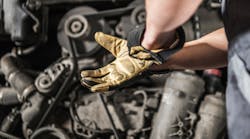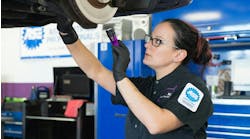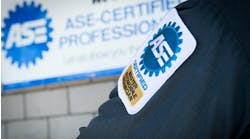Whenever there’s a discussion about the technician shortage, compensation for technicians often comes up. Automotive technician advocate WrenchWay found that 43% of technicians considered compensation as the biggest factor in staying at their current workplace. Given this, it seems all too easy to assume that publicly increasing technician pay would solve the industry’s labor problems. But unfortunately, it’s not that simple.
Even among various shop owners and dealers, methods to finance their technicians’ success and compensation can vary depending on the shop’s size and geographical area. To help find answers, in January shop management software provider Fullbay sat down with AM PM Diesel Services CEO Dale Bowman and operations manager Chase Bowman to discuss how the business funds its technicians. AM PM provides mobile truck and trailer service, repairs, and parts. Fullbay’s CEO Patrick McKittrick and COO Chris O’Brien led the discussion, in which the AM PM leaders explained how they handle funding their technicians while growing from a single mobile fleet truck to 18 shop locations nationwide.
Read more: Addressing top technician frustrations, according to WrenchWay
“Our slogan for a long time [has been]: ‘If you’re not turning, you’re not earning,’” said Dale Bowman, adding that the main goal is to “keep the trucks running on the road.”
To ensure this plays out on the shop floor, AM PM has thought long and hard about pay structure, technician hiring and expectations, and training, and shared their insights during the discussion.
Pay structure
Productivity and uptime begin at the ground level with the technicians, and AM PM keeps that foundation strong with a solid pay structure in place.
“Generally speaking, all of our mechanics are paid off the flat time,” Chase Bowman explained. “For instance, a brake job is about six to eight hours. We should get that done in about two hours so he gets paid the six hours, and then you can move on to the next job.”
By this reasoning, a highly skilled technician can boost their pay to $150,000 a year, he continued, with the addition of bonus packages and weekly stipends for added productivity, thus rewarding them for their efficiency and quality.
Both Bowmans touted the flat-pay method because it allows technicians to determine their own pay and produce higher earnings than hourly wages. Dale Bowman noted flat pay gets a bad rap because techs don’t always understand their earning potential. A technician getting paid hourly may say they are making $42.50/hour working at a dealership, so why would they leave for a flat rate, he posited.
“You have to explain to them that working commission, when you’re working in a customer’s parking lot or in their shops, the work is abundant,” Dale Bowman said. “You can do as much as you want to, and it’s never-ending .”
He theorized his technicians would say they need an offer rate of $145 per hour to be tempted away from AM PM Diesel Services and the money they make there.
Of course, the flat-pay math doesn’t always work out if the work isn’t abundant.
“If you don’t have the workload, like when we first open up a shop in a different location, what we will do is we’ll give our technician a guarantee,” Dale Bowman explained. “Basically, we’ll say, ‘Hey, we’re kicking this off. It’s a new location. For the next two months, we’re gonna give you X amount of money, guaranteed. If you don’t make that, we’re going to offset it to make you make that. But we will see in three months, and you will see, that the profit margins are there [and] the guarantee will go away. Then you start working completely on commission.’”
As soon as a technician has been set up in a shop, maintaining a proper balance in the workload-to-technician ratio is crucial to the Bowmans, including technician distribution between shops and between fleets. For shops, that means increasing the number of hours a technician can work, possibly by moving two employees from one shop to another to increase every worker’s paycheck.
Meanwhile, managing their remote operations with a fleet takes just as much planning.
“You’ve got to have a headcount on [the client’s] equipment,” Dale Bowman asserted. “The basic rule of thumb that you’ve got to have is for every 23 pieces of [Class 8] equipment, you’ve got to have one technician. If a customer has 230 pieces of equipment, that tells us we need 10 technicians. [Those] 10 technicians can handle that fleet completely from start to finish all the way from tires, brakes, oil changes, road calls, [and] welding fabrication.”
Ensuring repair quality
With such an emphasis on productivity, the flat-pay rate could lead to rush jobs and a serious drop in quality. But the Bowmans discussed how they have a system in place that emphasizes output and accuracy.
“We have lead techs at all our shops and also a service manager overseeing the work,” Chase Bowman said. “But we’ll handpick certain jobs and go out there and verify it was to the compliance standpoint we needed to be at, and we have very little warranty comeback work going through that process.”
To ensure quality work, AM PM Diesel Services also uses an additional incentive within their pay structure.
“We have an understanding with [senior technicians] that if they have comeback work, what we do is give them the option to do the repair over and to be overseen by another technician,” Dale Bowman explained. But the second repair comes with a catch. “They have to do the labor for free, and then we provide them with the parts to do the repair. If they have something that they mess up, it’s hurting their pocket as [much] as it’s hurting ours.”
Meanwhile, if a vehicle returns to the shop with a full failure, the Bowmans will have another technician redo the job in full, taking the money the first tech would have earned without the comeback.
“And usually, if we have another senior technician watch over the repair, they learn from their mistake, and it doesn’t happen again,” Dale Bowman asserted.
Training
Granted, neither the flat-pay structure nor the technician accountability would work without proper training of AM PM Diesel Services’ technicians, which is an investment in and of itself.
“[But] the company is worth that cost,” Chase Bowman agreed. “That’s the cost of doing business: training your people.”
That doesn’t mean a technician’s education should be funded without checkpoints in place to ensure their progress.
“As we have more mechanics, we’re sending more of our greener mechanics with our lead techs and getting them trained up,” Chase Bowman said. “We’ll stay with them for four to six weeks, and then they’ll do a skill assessment to see if all that training is paying off. Then we get that feedback and see if you need to go through [more] training or [if this is] a replacement game, [where] we need to find another mechanic.”
From Dale Bowman’s perspective, this means hiring technicians with the initiative and ingenuity to approach the jobs they need to make successful commissions, even if tasked with examining a part or process they haven’t been specifically trained in. When a mechanic is willing to work hard, no matter how new they are, they will improve simply by getting the job done, incorporating their training along with their turning and earning with the company.
The first step of this process means sending the senior technician on site to diagnose the vehicle before passing off the repair job to a newer employee.
“He may not be the fastest guy at it, but he’s gonna get better,” Dale Bowman asserted. “We know the truck’s diagnosed, right? [The senior technician] can go out there and say, ‘Hey, take this water pump off and replace it.’… And then, when that technician has done the job, the senior technician will go out and say, ‘Hey, let’s go look at your work. [If] the water pump’s good [and] not overheating, [and] there’s no leaks, [then] good job.’”




